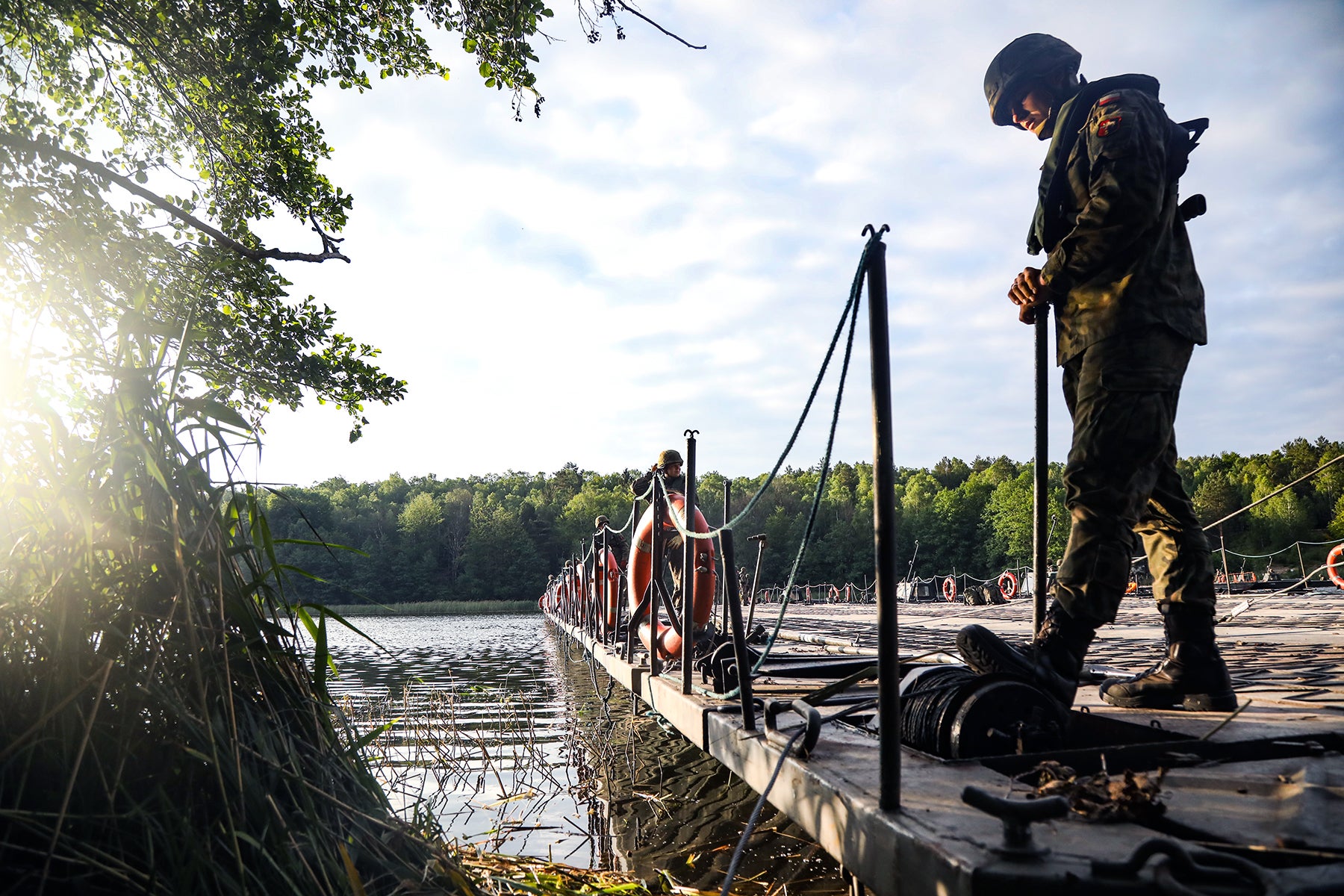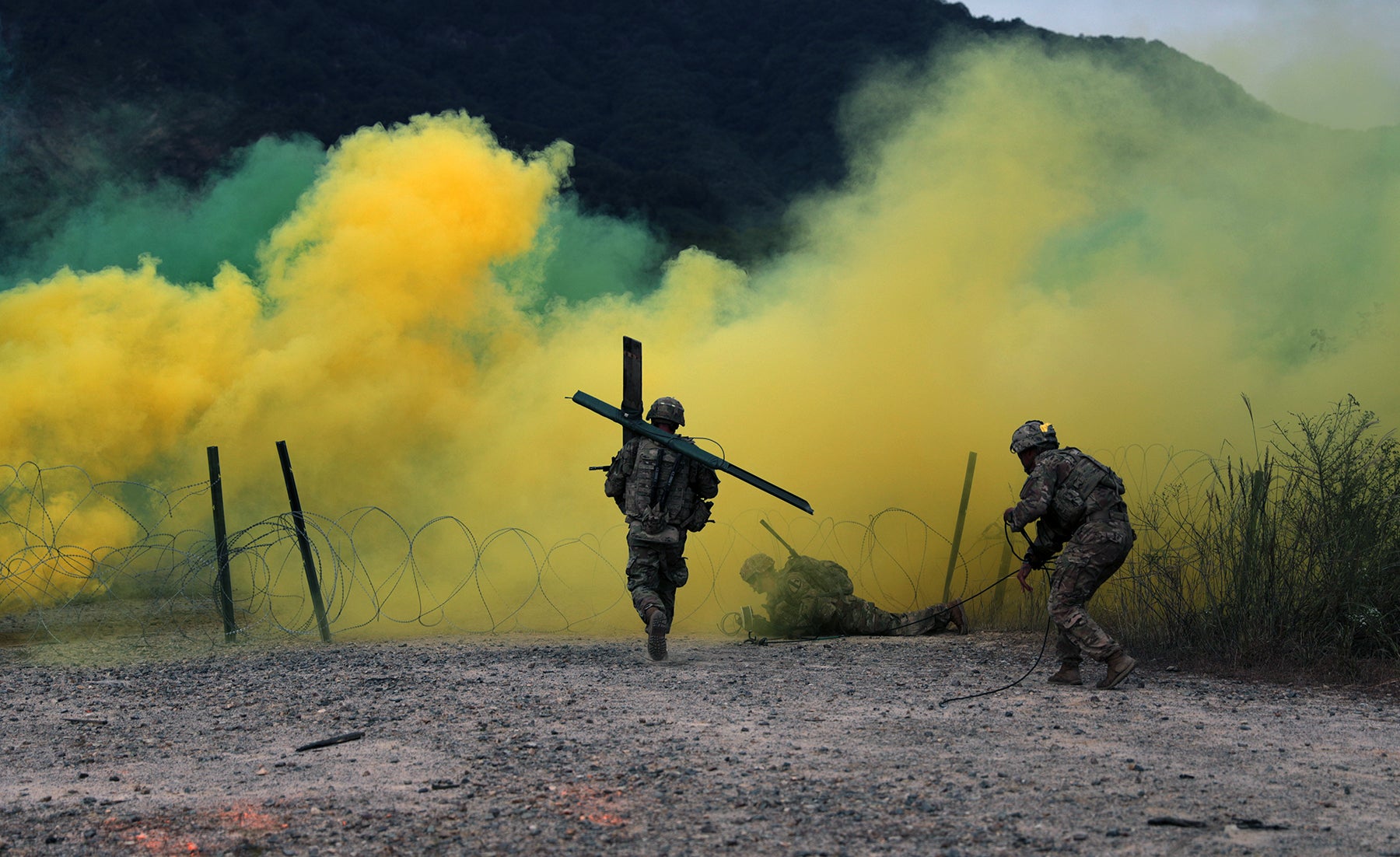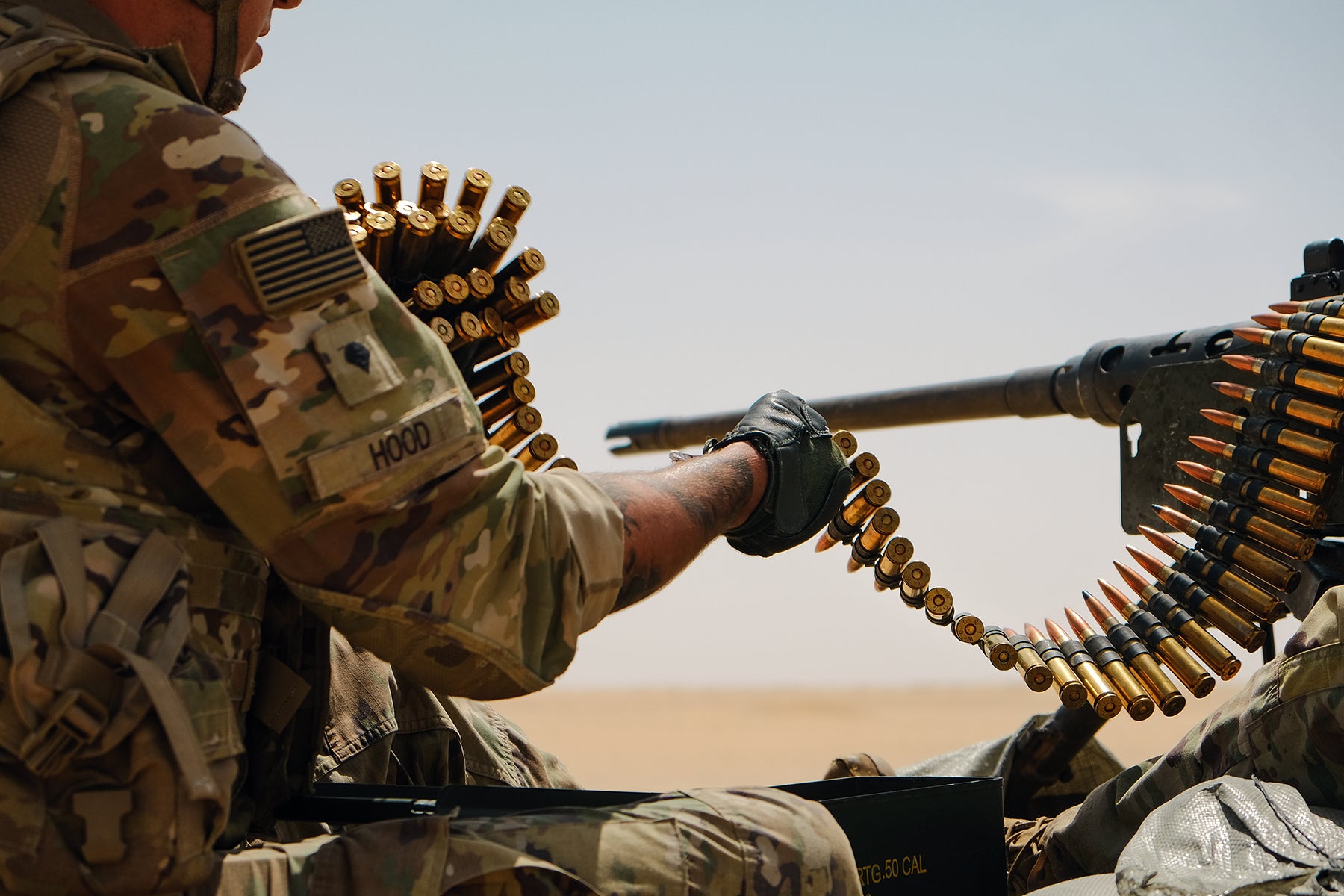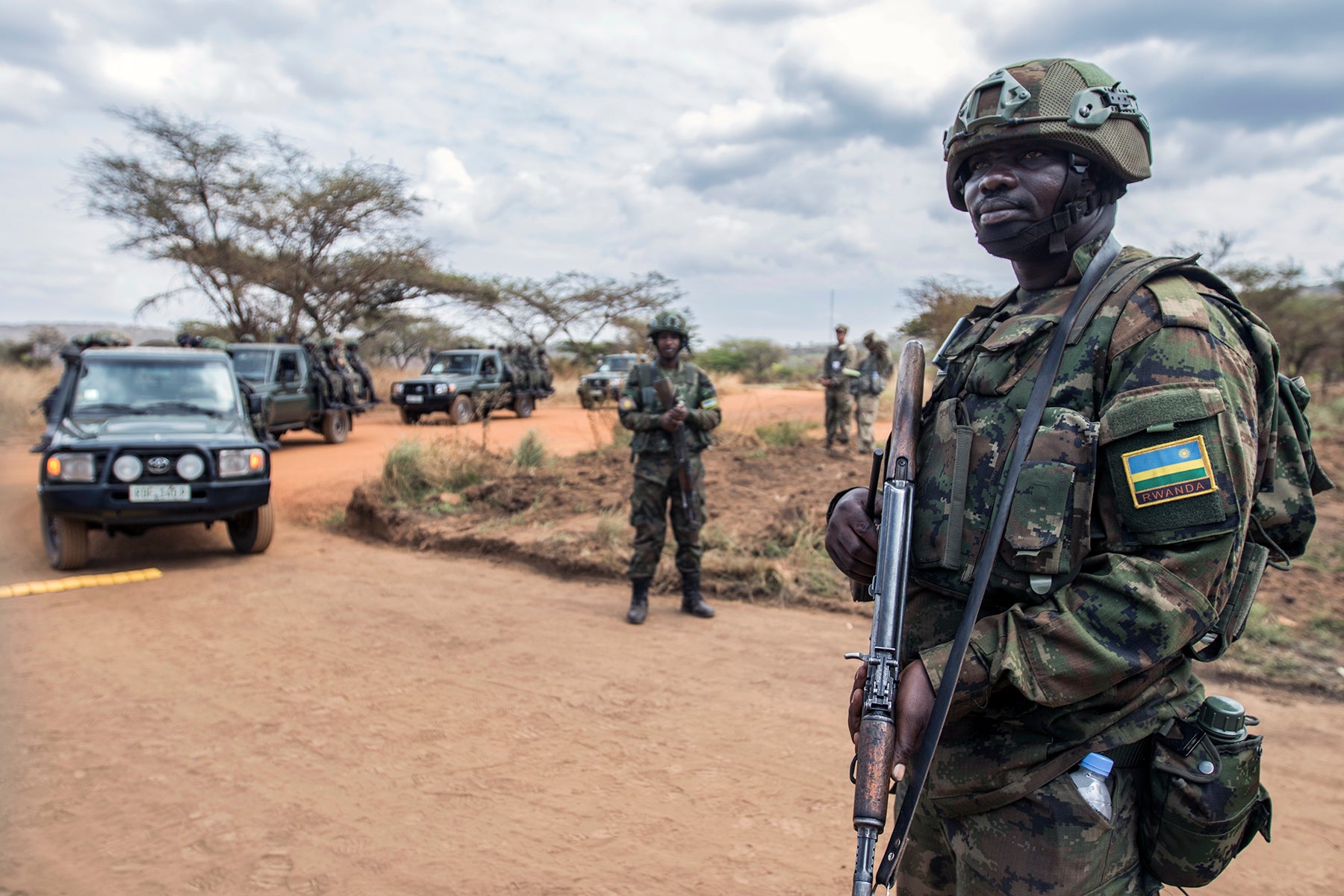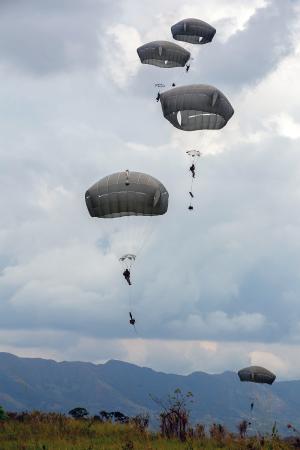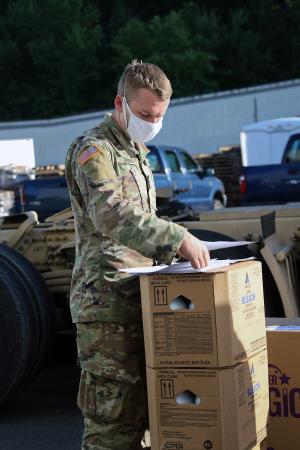The Army on Point: A Detailed Summary of Current Operations and Responsibilities
The Army on Point: A Detailed Summary of Current Operations and Responsibilities
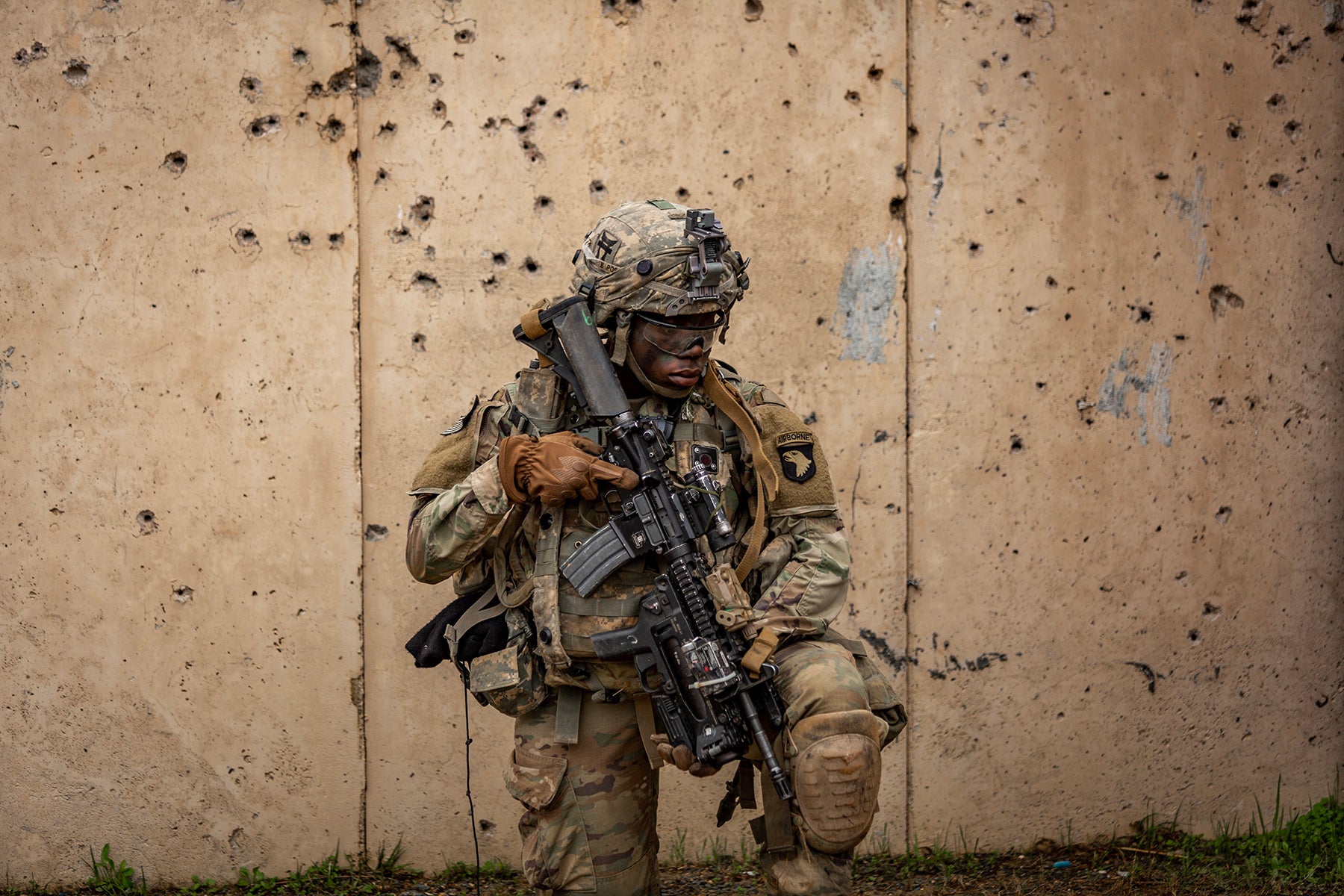
This report was originally published in 2020. Click here to view the updated 2022 version.
★ ★ ★ ★
Introduction
America’s Army is the most capable and lethal ground force in the world. It was founded on 14 June 1775, when the Second Continental Congress established the Continental Army, instituting the first service of the armed forces of the United States. For almost 250 years, Soldiers have built a legacy of character, competence and commitment, symbolized by the 190 campaign streamers that adorn the Army flag—each one signifying the great sacrifices of Soldiers on behalf of the nation and the American people. Today, the U.S. Army is a force that is prepared to defend the nation and protect America’s national interests, both at home and abroad, through prompt and sustained land combat.1
America’s Army—Regular Army, Army National Guard, Army Reserve—is a strategic force, capable of decisive action. Army forces are part of the joint force, deterring would-be aggressors, reassuring allies and partners, providing military support to civilian authorities and decisively winning today and tomorrow’s battles. In sum, Army forces compete below the level of armed conflict and they fight and win against great-power competitors.2
On the Front Lines
The Army has a global focus and, as such, continues momentum toward providing trained, ready and modernized ground forces to combatant commanders (CCDRs). Currently, the Army contributes to achieving objectives outlined in the National Defense Strategy by providing CCDRs over 180,000 active and reserve component Soldiers in more than 140 countries. Army forces comprise 60 percent of all combatant command (COCOM) requirements. This includes, among other commitments, over 27,500 Soldiers supporting operations in the Middle East; more than 10,000 Soldiers supporting operations in Afghanistan; 32,500 Soldiers supporting the North Atlantic Treaty Organization (NATO) and the European Defense Initiative; and over 21,000 Soldiers providing a forward American presence on the Korean Peninsula.3
The Army has arrayed these forces in three ways: forward-stationed, forward-deployed and U.S-based. What follows is a depiction of Army presence in numerous regions of the world and how the Army is truly part of a joint and multinational team able to compete and win in a multi-domain, strategic environment.
Europe
The Pacific
The Middle East
Africa
South America, Central America and the Caribbean
North America
Global: Army Special Operations Forces
Europe
The primary mechanism through which U.S. Soldiers are stationed in Europe is NATO. It has provided security and safeguarded members’ freedom since its inception in 1949. The U.S. Army presence in Europe represents more than 70 years of strong and steadfast commitment to regional stability and collective defense. The presence of Army forces reassures allies and partners and provides the physical and lethal deterrence necessary to counter threats to U.S. interests in Europe while honoring America’s commitment to NATO.
Together, the United States and Europe face a growing number of transnational threats that include great-power and hybrid military threats at levels less than armed conflict, violent extremism, global terrorism, illicit trafficking, the proliferation of weapons of mass destruction and infectious disease.4 Great-power competitors, such as an increasingly resurgent Russia, pose a formidable challenge to protecting U.S. vital interests. Current Russian aggression asserted itself in 2014, when Russia annexed Ukraine’s Crimean Peninsula. Additionally, Russian activities in the Arctic—increased basing, military hardware, exercises, etc.—have dramatically increased from 2017–2020.5 To counter this threat, the U.S. Army has both forward-stationed (under the lineage of 7th Army) and U.S.-based rotational forces (rapid reinforcement) trained and ready to deter and, if that fails, to fight and win.
U.S. Army Europe (USAREUR) is the Army Service Component Command (ASCC) of the joint U.S. European Command (USEUCOM). Headquartered in Wiesbaden, Germany, USAREUR and its subordinate commands provide to USEUCOM ready, lethal and combat-credible ground forces—airborne, Stryker, fires, sustainment—strategically positioned across 51 countries, to deter aggression and contribute to peace and stability in Europe. In the face of aggressive Russian actions in recent years, notably in the Donetsk and Luhansk oblasts of the Donbass region of Ukraine, the Army has bolstered its forward-stationed forces with rotational forces—combat-credible armored, aviation, logistics—deploying from the United States These nine-month rotations, in support of Operation Atlantic Resolve, not only increase capability and capacity, but also build readiness, increase interoperability and enhance the bond between ally and partner militaries through multinational training events.
USAREUR’s participation in more than 50 multinational exercises each year sharpens both strategic and tactical readiness. One of the most critical of these exercises is Defender Europe. Its purpose is to build strategic readiness by deploying a combat-credible force to Europe in support of the National Defense Strategy. Units deploy from the United States and, once in theater, draw Army Prepositioned Stock (APS) from locations in Germany and Belgium. They then spread out across the region and participate in various annual exercises. For Defender Europe 2020, the Army provided more than a division-worth of forces and equipment (13,000 Soldiers, 9,000 pieces of equipment and 2,000 heavy vehicles from APS).6
Regrettably, the scope and scale of Defender Europe 2020 had to be significantly reduced before its start date due to the worldwide pandemic COVID-19. Despite this, however, the main objectives of the build-up—strategic deployment, drawing on APS, coordination and execution of Host Nation Support (HNS)—were accomplished and provided a foundation for the conduct of future “Defender” exercises not only in Europe but also in the Pacific.7 Additionally, 6,000 U.S. and Polish soldiers participated in a June 2020 exercise—Allied Spirit—marking the U.S. Army’s gradual return to large-scale training exercises amid the COVID-19 pandemic.8
Moreover, active and reserve component Soldiers support NATO missions such as the Enhanced Forward Presence in Poland and the Kosovo Force. In addition, USAREUR conducts important regional security initiatives—the Georgia Defense Readiness Program and the Joint Multinational Training Group-Ukraine training mission.
The Pacific
For nearly 125 years, the U.S. Army has maintained a constant presence in the Indo-Pacific theater, assuring security and stability as an integral part of the joint force. As World War II ended, the Army’s leadership proved to be the cornerstone of renewed peace and prosperity in this region. The Army’s action at this juncture laid the foundation for some of America’s most critical and enduring international partnerships—Japan and South Korea, to name a few. Today, this region has reemerged as one of the world’s most militarily significant and challenging areas. Army partnerships are invaluable, as the majority of the 27 militaries in the region are led by local army officers.
American defense strategy emphasizes that the key to meeting future security challenges is to engage in sustained and persistent cooperation with America’s allies and partners. This is particularly true in the Indo-Pacific theater—where about three-fourths of the world’s population resides and more than three-fifths of the world’s economy thrives. Yet, not all countries in the region share this view. China is heavily investing in advanced military capabilities and seeks to change the current global balance of power. Although, for the present, Russia has the greatest capability to challenge U.S. interests, China presents America’s greatest long-term challenge. By 2030, it is expected to be the world’s largest investor in research and development and, by 2035, it is expected to array a fully modernized force that will contain artificial intelligence, robotics, energy storage, 5G networks, quantum information systems and biotechnology.9
The Chinese are also focused on joint, integrated operations across multiple domains of war. Tactically, its leadership has supported increasing naval force deployments and developing new air force assets. Strategically, the Chinese have sought to employ soft attacks with electromagnetic energy systems, followed by hard attacks. For example, cyberattacks or the use of electromagnetic pulse (EMP) weapons might precede precision kinetic weapons.10 In July 2019, General Mark A. Milley, Chairman, US Joint Chiefs of Staff, called China “the main challenge to the US national security over the next 50-100 years.”11
Counter these threats and overcoming the “tyranny of distance” (the Maldives to the coast of California is 9,000 miles), the Army operates through U.S. Army Pacific (USARPAC), the ASCC to the joint force. It provides forward-stationed and rapid-reinforcing, rotational forces, as well as an operational and deployable theater Army headquarters at Fort Shafter, Hawaii, to support U.S. Indo-Pacific Command (USINDOPACOM). USARPAC is engaged throughout this vast region, providing active and reserve component, combat-credible forces.
Forward-stationed in Japan, the U.S. Army Japan and I Corps (Forward), located at Camp Zama on the island of Honshu, is a major subordinate command of USARPAC. It is responsible for conducting bilateral relations between the United States and Japan, furthering the mutual defense of Japan and providing mission command in support of contingency operations in Asia. Also forward-stationed is the Eighth Field Army in Korea. Its mission is to provide mission command over multiple U.S. and multinational corps. It contributes to the joint force by providing intelligence, air and missile defense, theater communications, infrastructure and sustainment. Administrative and logistical responsibilities in Korea previously held by Eighth Army now reside with USARPAC, making it the sole ASCC for the theater. This realignment has allowed Eighth Field Army to exclusively focus on its operational mission, as well as implementing two bilateral agreements between the United States and South Korea. These agreements relocate U.S. Forces Korea from Seoul to Camp Humphreys in Pyeongtaek and consolidate the American footprint on the peninsula, thereby providing strategic depth on the peninsula.
In addition to the forward-stationed forces in Korea, the Army has provided, in nine-month intervals, combat-credible, rotational forces—an armored brigade combat team (BCT)—from the United States to bolster the defense of Korea. This capability to rapidly flow forces from the United States remains a cornerstone of America’s defense strategy. USARPAC also has available forward-deployed forces in or around the rim of the Indo-Pacific region. Together with the ever-increasing capability and readiness of APS in theater, these measures strengthen the American network of allies and partners and improve the Army’s ability to conduct large-scale combat operations against great-power competitors.12
Expeditionary mission command capability is extremely important to the joint force in this theater, and the Army provides numerous response options to meet this need. Beyond large-scale assets such as a deployable corps, a corps (forward) and a division headquarters, USARPAC has a smaller-scale contingency command post—a rapidly deployable mini-theater army headquarters—that can perform mission command functions for up to a month anywhere in the region without augmentation. Combined with Eighth Field Army’s capability to support joint operations outside of the Korean peninsula, USINDOPACOM has in its tool kit an agile, scalable Army mission command capability.
The Army’s theater engagement and partnership program has been a bedrock of American defense cooperation for many years. Such engagement improves the readiness of Army forces and their partners, reinforces U.S. commitments, assures regional powers of U.S. intentions and strengthens cooperative networks with emerging powers. Military relationships with U.S. allies in the region—Australia, Japan, Korea, the Philippines and Thailand—remain strong. They do so, in part, because of USINDOPACOM’s Pacific Pathways program, which has sent three, unit rotations to the Indo-Pacific region for the past five years to partner with countries like Indonesia, Thailand and Malaysia. This initiative supports the full spectrum of contingency responses by placing combat equipment afloat that moves from country-to-country conducting exercises. The Army’s senior leadership hopes to expand the length of these rotations from three to six months.13
These multinational, Army-led exercises throughout the region are central to the development of partner military capabilities and the demonstration of U.S. expeditionary capability. For example, Cobra Gold is one of the largest theater security cooperation exercises in theater and is an integral part of the U.S. commitment to strengthen engagement. This annual exercise occurred at various locations throughout Thailand in February and March 2020. The annual bilateral command post exercise—Yama Sakura—with the Japanese Ground Self-Defense Force in December 2019 included elements of I Corps demonstrating U.S. resolve to support security interests of allies and partners.
Additionally, in July 2020, Chief of Staff of the Army General James McConville met with the Thai leadership to sign a Strategic Vision Statement, one more concrete step—focused on modernization, interoperability, joint training and doctrine—undertaken in an effort to reassure allies about American commitment to the region.
The Middle East
The Middle East has been a volatile region since the breakup of the Ottoman Empire in World War I. The United States, along with other nations, has tried to create stability and security for the region for almost 50 years, often involving U.S. military forces, most recently in Afghanistan and Iraq. Currently, regional state adversaries, such as Iran, present significant challenges as they pursue advanced capabilities and weapons of mass destruction to gain regional influence and ensure regime survival. Moreover, transnational terrorist organizations continue to threaten U.S. vital interests, as well as those of U.S. allies and partners, throughout this region.14
In the early 1980s, the Middle East emerged as a complex region requiring a broad and continuing U.S. focus. Unfortunately, DoD’s ability to adequately resource this theater faced numerous challenges, such as overflight restrictions enroute to the theater, limited access into the theater and few fixed bases once there. To overcome these conditions, DoD formed a standing rapid deployed joint task force, headquartered in Florida, to respond to threats emanating from this area of the world. It soon became apparent, however, that in an area of responsibility (AOR) which covered more than 4 million square miles, included 20 countries and intersected three continents, a new command arrangement was necessary, one that not only would have command and control (C2) over U.S. forces, but would also have directive authority regarding logistics and sustainment. These conditions and challenges led to establishment of a new unified command—U.S. Central Command (USCENTCOM) in March 1982. Its broad and continuing mission is to protect U.S. vital interests in the Middle East. Since its establishment, USCENTCOM has played an important role in executing America’s defense strategy in Iraq, Afghanistan, Syria and other countries in the region.
The U.S. Army is postured, through enduring forward-presence and robust and capable partnerships, to protect U.S. national interests in this region; it also has the capability to rapidly transition to command joint and coalition forces to defeat emerging threats. Initially, U.S. Third Army was the command responsible for continuous oversight and control of Army operations in support of USCENTCOM. In June 2006, Third Army was redesignated as USCENTCOM’s ASCC, U.S. Army Central Command (USARCENT), with a main command post on Shaw Air Force Base in South Carolina. In addition, USARCENT has a forward command post located on Camp Arifjan, Kuwait, with Area Support Groups in Kuwait, Qatar and Jordan.
USARCENT also leads several named operations that are actively engaged in counterterrorism and in advising in hostile territory as part of other multinational missions. Since there are limited numbers of ground forces assigned to USARCENT, the Army provides rotational forces as well as no-notice reinforcing forces from the United States to enhance capabilities and capacity in the theater. The command regularly participates in 18 exercises and more than 200 engagements with its allies and partners.15
Afghanistan: Operation Freedom’s Sentinel (OFS). In response 9/11, Operation Enduring Freedom (OEF) was launched on 7 October 2001, with the mission to destroy terrorist training camps and the al Qaeda infrastructure within Afghanistan. The initial focus of OEF was to destroy the regional terrorist threats and then to prevent Afghanistan from becoming a safe haven for al Qaeda and other extremist organizations. OFS is the follow-on campaign that replaced OEF on 1 January 2015; at that time, 13,000 military personnel from 41 nations (10,000 from the United States) commenced a new NATO mission called Resolute Support (RS). This mission focuses the coalition’s effort on training, advising and assisting (TAA) the Afghan security institutions and the Afghan National Defense and Security Forces. In essence, U.S. forces—infantry, aviation, security forces assistance brigade (SFAB)—have two missions in Afghanistan: conduct counterterrorism operations; and execute TAA in support of RS.
Iraq and Syria: Operation Inherent Resolve (OIR). In March 2003, a coalition led by the United States invaded Iraq and overthrew the government of Saddam Hussein—Operation Iraqi Freedom (OIF). Though Hussein was captured in December of that same year and was subsequently executed, the conflict continued for much of the next decade as an insurgency emerged to oppose the coalition and the newly-formed Iraqi government. In 2011, the United States withdrew from Iraq; however, three years later, a new coalition, also led by the United States, was formed to counter the insurgency. On 15 October 2014, DoD designated Operation Inherent Resolve (OIR) to degrade and destroy the Islamic State, frequently known as ISIS. This was followed two days later by USARCENT being designated as the commander of the Combined Joint Task Force-Operation Inherent Resolve (CJTF-OIR). In this role, CJTF-OIR established a combined (multinational) and joint (multiservice) headquarters to oversee operations. The U.S. Army has provided both general purpose—airborne, armored, etc.—as well as special operations rotational forces to OIR. In addition to named operations, approximately 2,500 Soldiers from the Army’s no-notice ready brigade in the U.S. rapidly deployed to Iraq in late December 2019—one battalion in 21 hours and one BCT in 122 hours—to bolster security in the USARCENT area after a rocket attack killed an American contractor in Iraq and the U.S. Embassy in Baghdad was stormed.16
Sinai Peninsula: Multinational Force and Observers (MFO). MFO is an organization of 12 countries: Australia, Canada, Colombia, Czech Republic, Republic of Fiji Islands, France, Italy, New Zealand, Norway, the United Kingdom, the United States and Uruguay. The U.S. Army provides the single largest contingent to the MFO. The operation, which began on 25 April 1982, supervises the Egyptian-Israeli Peace Treaty and aims to prevent violations of the treaty’s terms. MFO duties include the operation of checkpoints, reconnaissance patrols and observation posts along the international boundary separating Egypt and Israel on the Sinai Peninsula. It also ensures freedom of travel through the Strait of Tiran. Contingents in the MFO rotate in and out of the Sinai Peninsula using a system of progressive personnel changeover, except for the U.S. infantry battalion, which rotates as a unit.
Africa
The land mass of Africa is larger than the United States, China, India, Japan and all of Europe combined. This vast continent of opportunity and promise also includes strategic challenges from malign competitors and violent extremist organizations (VEOs). Of the 1.3 billion people who live in Africa, more than two-thirds live in conditions of astonishing poverty. Lack of economic opportunities and a search for a better life leads to internal displacement and refugees, which creates new challenges and conflicts over increasingly scarce resources. Combined, these and other factors feed a lucrative market for VEOs and criminal networks. In general, African governments view VEOs as near-term threats to their capacity to effectively govern.17
That said, over half of the world’s farming land is in Africa and, when effectively managed, Africa’s population growth and rich natural resources drive progress. It is worth noting that 26 African nations hold reserves of minerals determined to be critical to the U.S. economy and national security. Regrettably, China and Russia have long recognized the strategic and economic importance of Africa and continue to seize opportunities to expand their influence across the continent. China is outpacing all of its competitors in Africa where, with the construction of a military port and helicopter landing pads, it is converting its first overseas military base in Djibouti into a power projection platform. In the last seven years, China’s arms sales to African partners have added up to over two billion U.S. dollars (USD). During this same period, Russia has increased access agreements by 200 percent and remains the top arms dealer for the entire continent, selling nearly nine billion USD in arms. In tandem, China and Russia are eroding U.S. influence and access in the region; they are enduring threats to America’s vital interests.18 Fortunately, DoD has a unified command—U.S. Africa Command (USAFRICOM), headquartered at Stuttgart, Germany—that oversees U.S. security interests in this region. Simply put, this command and its partners counter transnational threats and malign actors, strengthen security forces and respond to crises, advancing U.S. national interests and promoting regional security and stability.19
The U.S. Army’s involvement in Africa dates to 25 October 1955, when the Southern European Task Force (SETAF) was activated in Italy. During the latter half of the 20th century, the Army recognized the need for contingency forces for this region and increased its force levels by adding an airborne battalion combat team and a signal support unit, together with taking operational control of two Army artillery groups in Greece and Turkey. From the early 1990s through the first decade of the 21st century, SETAF became the C2 headquarters for Army and joint units—a joint task force headquarters (JTF-HQs). The headquarters and/or its elements led operations in northern Iraq (Operation Provide Comfort), Entebbe Uganda, Rwanda, the Congo, Libera, Afghanistan, Romania, Bulgaria and the Republic of Georgia. By then, the airborne battalion had evolved into SETAF’s 173rd Airborne Brigade, which conducted a parachute assault into northern Iraq in March 2003. By 2006, the 173rd Airborne Brigade transformed into an airborne BCT and deployed again in May 2007, this time to Afghanistan.
Recognizing the broad mission set and the increased importance of Africa to America’s national security interests, the Army redesignated SETAF to be USAFRICOM’s ASCC—U.S. Army Africa (USARAF)—headquartered in Vicenza, Italy. USARAF provides mission command, sets the theater, conducts security force assistance and supports joint and international partners. It also serves as the JTF-HQs in support of USAFRICOM contingency operations, arguably its most important mission. The 173rd Airborne BCT and its supporting active and reserve component units largely comprise Army forces in the theater as part of the lineage of Ninth Army.
To assess USARAF’s capability, the Chairman of the U.S. Joint Chiefs of Staff sponsored, and USAFRICOM scheduled, a combined joint exercise—African Lion 20—which was to be conducted in Morocco with related activities in Tunisia, Senegal, Italy and the United States. USARAF established the exercise’s combined JTF-HQs, integrating USAFRICOM’s components and internal partners, to solve a complex, trans-regional crisis. Nearly 4,000 U.S. servicemembers began to join approximately 5,000 military personnel from Morocco, Tunisia, Senegal, Spain, the United Kingdom and the Netherlands in USAFRICOM’s largest exercise to date. However, due to COVID-19, the exercise was initially merely scaled back (deployments continued) but was eventually entirely cancelled just prior to its planned start date of 23 March 2020. Some exercise objectives were still met, however, and they are being used to formulate planning for African Lion 21.
Another important mission is the Combined Joint Task Force-Horn of Africa (CJTF-HOA) in Djibouti. This joint task force comprises Soldiers and servicemembers from other U.S. armed forces, civilian employees and representatives of coalition and partner countries. Using a whole-of-government approach to face challenges in this region, CJTF-HOA focuses on military-to-military activities as well as humanitarian initiatives, including digging wells and building schools. Ultimately, it works to promote security in the region—a goal that inevitably reaches far beyond the immediate area. Established at Camp Lejeune, North Carolina, in 2002, and now located at Camp Lemonnier in Djibouti City, Djibouti, CJTF-HOA has supported conducting medical civil action and veterinary civil action projects in addition to the building of schools, clinics and hospitals.
South America, Central America and the Caribbean
Between the end of the Vietnam War and 9/11, the U.S. military was involved in three armed conflicts. Two of the three—Operation Urgent Fury in Grenada and Operation Just Cause in Panama—occurred in the U.S. Southern Command (USSOUTHCOM) AOR. This area encompasses 31 countries and 15 special sovereignty areas across more than 15 million square miles, including all of the Central and South American landmass and adjacent water south of Mexico, and the Caribbean Seas and island nations. This environment presents challenging conditions such as unequal wealth distribution, social exclusion and corruption. It also poses a unique combination of security issues: transnational organized crime, illicit networks, mass migration, narco-terrorism and natural disasters.
Joint, interagency, intergovernmental and multinational commitment has quietly but effectively prevented additional armed conflict, but this environment remains influenced by persistent tensions, challenging conditions and security issues that make it imperative to maintain an engaged, committed presence in the region. Conditions in the AOR, just a short distance from the U.S. southern coast, present a real and present danger to the homeland.
In 2019, the Chinese government absorbed three more Latin American countries into its “One Belt One Road” initiative, bringing the regional total to 19—more than half of all countries in the region. China now has 29 government exchange programs with Latin America and the Caribbean, and it continues to expand offers of professional military education, equipment donations and funding for infrastructure projects. Russia once again projected power into the region, establishing a military footprint in Venezuela; deploying for the first time its most advanced nuclear-capable warship; and sending a research ship capable of mapping and cutting underseas cables, as well as two other naval research vessels to operate near the North America continent. Under Russian and Cuban tutelage, oppression in Venezuela is ever-increasing. Iran, which has exported its state-sponsored terrorism to the Americas in the past, maintains facilitation networks and raises funds through its proxy, Lebanese Hezbollah. Having a footprint in the region also allows Iran to collect intelligence and conduct contingency planning for possible retaliatory attacks against U.S. and/or Western interests. These malign state actors are part of a vicious circle of threats that deliberately erode stability and security in the region.20 USSOUTHCOM, headquartered in Miami, Florida, is postured to counter these threats and maintain the regional balance of power in favor of the United States by recognizing the importance of and strengthening partnerships within the region.
The U.S. Army, with a long history in the Caribbean and Central and South America, continues to share responsibility for fostering peace and stability in the Western Hemisphere. U.S. Army South (USARSOUTH)—the ASCC of USSOUTHCOM—conducts and supports multinational operations and security cooperation in this AOR to counter transnational threats and strengthen regional security in defense of the homeland. It also can be required to serve as a Joint Task Force Land Component Command or JTF as directed. Headquartered at Fort Sam Houston in San Antonio, Texas, USARSOUTH has supported U.S. national security objectives in the region through proactive engagement and enduring partnerships with its judicious use of limited assigned forces—intelligence, signal, sustainment and medical under the lineage of Sixth Army. The command maintains depth through regional alignment with Regular Army, Army National Guard and Army Reserve units. USARSOUTH regional efforts are also integrated with and complemented by 19 National Guard State Partnership Program units that maintain enduring relationships with 22 counterparts in the AOR. This combination of active and reserve forces provides a scalable, flexible, agile and responsive team with unique professional skills and unmatched experience.
Contingency response represents the most likely venue for the deployment of Army forces in this AOR. The unique geographical characteristics of the region make it vulnerable to devasting natural disasters, which often require international support to save lives and mitigate suffering. In addition to frequent hurricanes and destructive earthquakes, the region is also affected by volcanoes, mudslides, flooding, fire and tsunamis. As the largest of the USSOUTHCOM components, USARSOUTH is tasked to form the core of a JTF for contingency response. It maintains a C2 node capable of responding to short-term contingency requirements. Within 72 hours, it can deploy in response to natural disasters and catastrophic events throughout the AOR. The initial deployment package can be expanded to a larger contingency command post or joint task force, depending on the severity of the contingency event.
In Central America, USSOUTHCOM’s Joint Task Force-Bravo (JTF-B) has built collective response and security capability and readiness in Army forces and partner militaries. Established in 1984, its mission is to: conduct and support U.S. joint, combined and interagency operations that increase regional security; support interagency operations in coordination with U.S. military and U.S. embassy country teams; support regional humanitarian and civic assistance, disaster relief and contingency missions; and plan, coordinate and conduct regional search and rescue operations. In 2019, JTF-B provided: medical care to over 20,000 partner nation patients; rapid response capability for a wide range of contingencies; and assigned forces to participate in exercises.21
An example of strengthening partnerships in the region is the recent army-to-army partnership initiatives with Brazil. The Commanding General of USARSOUTH accompanied the Brazilian Army Chief of Training to the U.S. Army’s Joint Readiness Training Center (JRTC) at Fort Polk, Louisiana in early February 2020 where the Brazilian Army plans to send their airborne soldiers for training. Originally agreed to in 2016 as part of the bilateral U.S.-Brazil Army five-year plan, Brazil plans to send a company of paratroopers from its 27th Airborne Battalion located in Rio de Janeiro where they will train with the 1st Brigade, 82nd Airborne Division paratroopers in 2021. The overarching objective is achieving interoperability across the human, technical and procedural dimensions. This initiative is an investment not only for the Soldiers of each country, but also for strengthening ties between two of the world’s most robust democracies.
North America
The 21st-century world faces a complex set of challenges that do not fit into traditional categories. Historically, the U.S. homeland largely been spared the catastrophic events seen in much of the rest of the world. However, since 9/11, the steady convergence of terrorism, hybrid threats, natural disasters, the recent COVID-19 pandemic and civil unrest across the nation—coupled with the instability and uncertainty of the global environment—requires the United States to prepare for contingencies on its own soil. Protecting citizens, mitigating the impacts of crises and preserving the American way of life are enduring Army concepts. These concepts require constant attention and the ability to anticipate and quickly respond to any type of mission, regardless of location. A secure homeland is vital to U.S. interests at home and abroad.
The strategic threat to the homeland has entered a new era. Key adversaries Russia and China have deployed and continue to advance a range of capabilities to hold the homeland at risk with nuclear, conventional and cyberspace weapons. Additionally, these adversaries are taking actions below the level of armed conflict to erode U.S. global influence. For example, throughout 2019, Russia continued its expansion of military infrastructure in the Arctic by lengthening existing runways and building new ones. China invested heavily in the Arctic Region, proclaiming itself to be a “near-Arctic” nation. Geographically, the Arctic is no longer a fortress wall and the oceans are no longer protective moats for the United States; they are now avenues of approach for advanced conventional weapons and the platforms that carry them. North Korea, Iran and VEOs remained committed to attacking the United States, either directly or indirectly by inspiring homegrown violent extremists. If successful, the many threat capabilities can not only destroy or incapacitate U.S. defensive systems, but also severely degrade DoD’s ability to project military force from the United States into other theaters in response.22
To defend against these 21st century threats, the homeland defense enterprise reflects the fact that these threats have expanded beyond violent extremism. In fact, U.S. Northern Command (USNORTHCOM), headquartered at Peterson Air Force Base, Colorado, was originally established on 25 April 2002 in recognition of the violent extremism. Today, USNORTHCOM has refocused its efforts to not only counter violent extremism, but also to deter and defeat the complex nation-state threats and adversarial strategies that have eroded America’s advantage.23
U.S. Army North (USARNORTH)—the ASCC of USNORTHCOM—forms the foundation, along with its many partners, of a deep and credible protection of the homeland. This requires a careful and deliberate blend of military, civilian and law enforcement elements into a unified, mutually supporting team. In pursuit of that goal, three key missions emerge: conducting theater security operations with the partner nations of Mexico and Canada; planning, training and conducting theater sustainment and response efforts as the joint force land component command (JFLCC); and providing C2 to federal forces that support domestic law enforcement and disaster relief agencies responding to a range of contingencies. Also headquartered at Fort Sam Houston, Texas, USARNORTH is building the enduring relationships—inside and outside of the United States—to accomplish those missions and defend the homeland through the prevention of threats and, in the event of crisis, swift support of civil authorities.
USARNORTH consists of limited organic forces (e.g., Task Force 51, a scalable, deployable command post) as part of the lineage of Fifth Army, but it does have assigned, allocated or operational control (OPCON) active and reserve forces. These non-organic units perform critical functions such as mission command, sustainment, intelligence and air and missile defense (e.g., the Army National Guard’s 167th Theater Sustainment Command and Task Force 76, a deployable Army Reserve element, providing C2). Since homeland defense is USARNORTH’s top priority, it is prepared to assume OPCON of dedicated ground forces anywhere in the continental United States (CONUS) to deter, detect and defeat threats against America and its people, to include protecting DoD’s ability to project combat power globally.
The COVID-19 pandemic of 2020 has placed the U.S. Army and, in particular, USARNORTH/Fifth Army, the Army Medical Corps and the U. S. Army Corps of Engineers (USACE) at the center of the military’s response in support of civil authorities. In May 2020, the Army’s senior leadership—the Secretary of the Army, the Chief of Staff of the Army and the Sergeant Major of the Army—addressed the Army’s response to this crisis.24 Among other matters, they highlighted the Army’s: immediate support to local, state and federal governments; many enabling capabilities that are critical to large-scale contingency operations; and a comprehensive approach to ensuring readiness for such operations as these. They noted that the Army is uniquely suited to respond to the pandemic because of its multicomponent structure. All components—Regular Army, National Guard, Army Reserve—are in the fight. Through them, the Army is supporting local, state and federal requirements with unique capabilities, while maintaining trained and ready forces that can respond to multiple simultaneous contingencies worldwide.
USARNORTH, growing to more than 1,000 personnel, is the JFLCC, integrating the myriad capabilities provided by active and reserve component Army forces—medical, logistics, C2, etc.—as well as other governmental agencies supporting the COVID response force. Governors in all 54 states and territories activated more than 46,000 Army National Guard Soldiers in tailored and scalable units to provide critical capabilities for local incident response commanders. The Army Reserve activated 1,190 medical personnel in more than a dozen Urban Augmentation Medical Task Forces (UAMTFs) to reinforce civilian medical personnel at hospitals in impacted communities across the nation. Among other missions, USACE redesigned the Jacob K. Javits Convention Center in New York City into a nearly 3,000-bed health care facility, equipping it with Federal Emergency Management Agency deployable hospital equipment. USACE continued to provide “build” options to local and state leaders across the country, helping them tailor each location to local requirements. In sum, this was a Total Army approach in the fight against COVID-19.
Global: Army Special Operations Forces (ARSOF)
SOF plays a significant role in U.S. military operations and, in recent years, has been given greater responsibility for planning and conducting worldwide counterterrorism operations. U.S. Special Operations Command (USSOCOM) has more than 70,000 active duty, National Guard and reserve personnel from all four services and the DoD civilians assigned to its headquarters at MacDill Air Force Base, Florida, its four service component commands and eight sub-unified commands.25
The U.S. Army Special Operations Command (USASOC)—the ASCC of USSOCOM—is among the most diverse organizations in the U.S. military, bringing a broad range of competencies and disciplines to support CCDRs and ambassadors worldwide. Headquartered at Fort Bragg, North Carolina, the fundamental mission of USASOC is two-fold: to organize, train and equip ARSOF units and Soldiers; and to deploy them worldwide to meet the requirements of war plans, COCOM Theater Security Cooperation Plans and ambassadors’ Mission Strategic Plans.
★ ★ ★ ★
Colonel George P. Coan, Jr., retired from the U.S. Army in 1999 after over 30 years of active service. He commanded field artillery units in both Europe and the Pacific and served in Australia as the U.S. Army Attachè during the early 1990s. His high-level staff assignments included service on the Joint and Army Staffs and as the senior active component officer in the National Guard Bureau. He also commanded the Force Management Integration Agency at Fort Belvoir, Virginia. His concluding assignment was Chief, Commemorations, Office of the Deputy Under Secretary of the Army (International Affairs). After retirement from the Army, Colonel Coan served for 16 and a half years as the Director of National Security Studies at the Association of the United States Army (AUSA); he still works with AUSA as a consultant.
A 1969 graduate of the United States Military Academy at West Point, New York, he also holds an MA in Public Administration from the University of Oklahoma and is a graduate of the U.S. Army War College. Colonel Coan and his wife, Pam, live in Manassas, Virginia; they have four children and eight grandchildren.
1 Department of the Army, Army Doctrine Publication (ADP) 1, The Army (Washington, DC: U.S. Government Printing Office, 31 July 2019), v.
2 Ryan D. McCarthy and James P. McConville, Army Posture Statement, 3 March 2020, 2, https://www.army.mil/e2/downloads/rv7/aps/aps_2020.pdf?st.
3 Army Posture Statement, 3.
4 “Mission & History: Why It Matters,” U.S. Army Europe, http://www.eur.army.mil.
5 David A. Wemer, “NATO’s defense depends on mobility,” Atlantic Council, 23 April 2020.
6 Wemer, “NATO’s defense depends on mobility.”
7 Christopher Woody, “The US Army is rethinking how to do its largest European exercise in 25 years amid a coronavirus lockdown,” Business Insider, 17 March 2020.
8 Specialist Cody Kellum, "Polish, U.S. Joint Exercise Allied Spirit Concludes," Army News Service, 25 June 2020.
9 Army Posture Statement, 2.
10 Larry Wortzel, “What the Chinese People’s Liberation Army Can Do to Thwart the Army’s Multi-Domain Task Force,” AUSA’s Institute of Land Warfare, Land Warfare Paper No. 126.
11 Bradley Bowman and John Hardie, “Aligning America’s Ends and Means in the Indo-Pacific,” Defense News, 22 April 2020.
12 Office of the Director of the Army Staff, “Army Posture Statement 2020,” Stand-To!, 13 March 2020.
13 Kyler Rempfer, “Soldiers will spend longer deployments in Asia,” Army Times, 20 February 2020.
14 Army Posture Statement, 2.
15 “About Us: Our Enduring Priorities,” U.S. Army Central, https://www.usarcent.army.mil/About/.
16 Chad Garland, “Thousands of 82nd Airborne paratroopers to return home after rapid deployment to the Middle East,” Stars and Stripes, 26 April 2020; Army Posture Statement, 5.
17 Stephen Townsend, United States Africa Command Posture Statement, 30 January 2020, 2.
18 United States Africa Command Posture Statement, 3–4.
19 United States Africa Command Posture Statement, 1.
20 Craig S. Faller, United States Southern Command Posture Statement, 30 January 2020, 1–2, 5–6.
21 United States Southern Command Posture Statement, 7.
22 Terrence J. O’Shaughnessy, United States Northern Command and North American Aerospace Defense Command Posture Statement, 13 February 2020, 2–4.
23 Ibid., 8–9.
24 Ryan Mccarthy, James Mcconville, Michael Grinston, “The Fight Against Covid-19: A Total Army Approach,” ARMY, 2 April 2020.
25 USSOCOM Office of Communication, Fact Book: United States Special Operations Command, 2020, https://www.socom.mil/FactBook/2020%20Fact%20Book.pdf.


